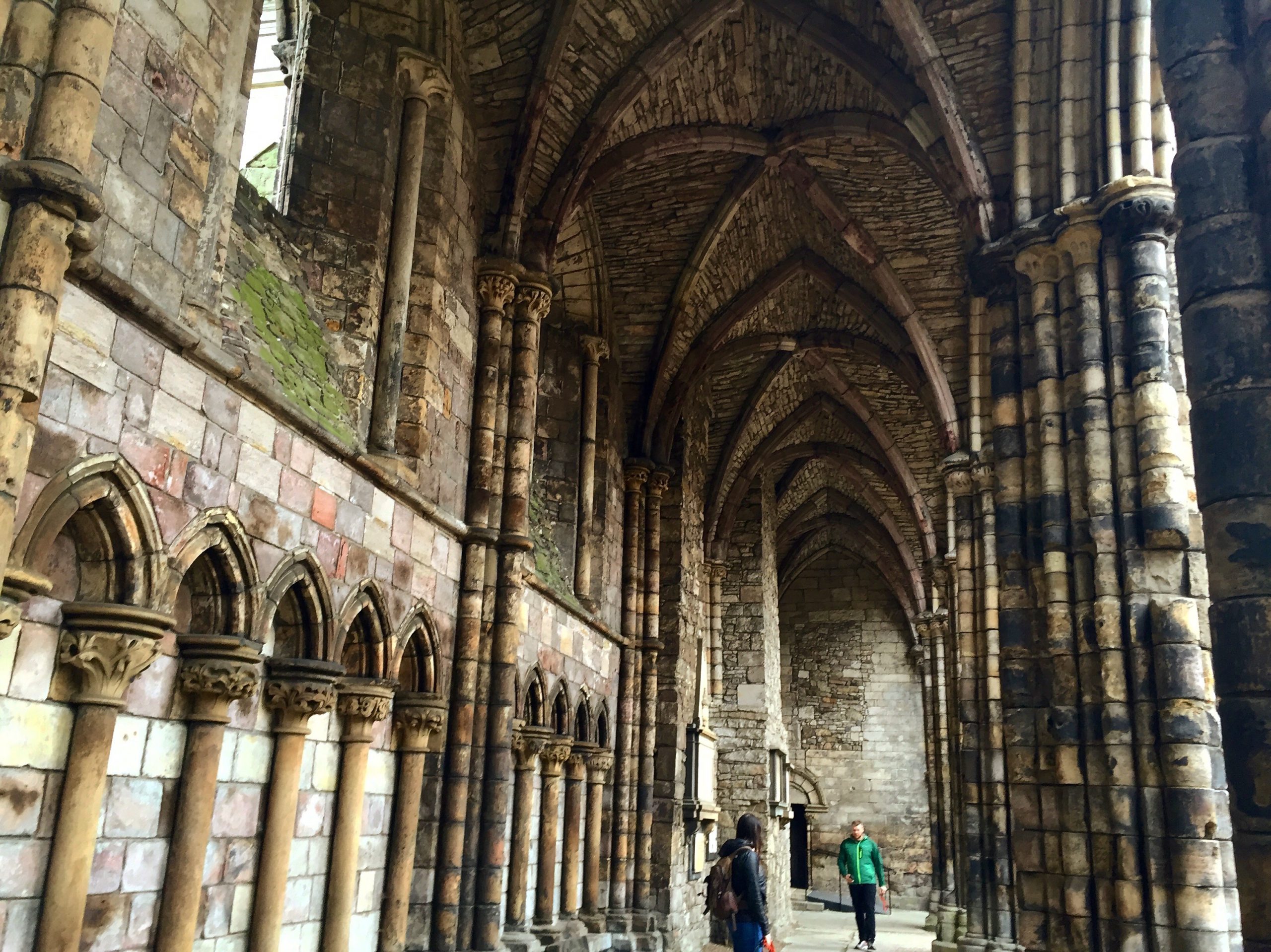Today, we may as well have been on tour of Mary, Queen of Scots’ life within Edinburgh and its surrounding areas. We visited three homes where she lived during her relatively short life – Holyrood Castle, Edinburgh Castle and Linlithgow Palace.
I have written before about my little obsession with Queen Mary of Scots so I won’t elaborate on that too much except to say that it was an incredible personal experience to see the places where she was born, where she gave birth to her only living son, and where her mother Marie Guise died. If you’re interested in reading about Mary I highly recommend the biography by Antonia Frasier and “The Life of Mary: Queen of Scots: An Accidental Tragedy” by Roderick Graham.

We had stayed overnight in a gorgeous small hotel and we were very close to both Holyrood and Edinburgh Castles, which are within the city center, so we chose to see Holyrood first. It was directly across the road from the Scottish Parliament, which is an odd looking modern building.
Holyrood Castle
This was the first place where we had to line up to purchase our tickets. It was a very small ticket office for such a popular tourist attraction. I have a big problem with patience and general human stupidity so this kind of setting is a nightmare for me. I was immediately cranky and, I may or may not, have said nasty things under my breath about the people at the front of the line.

When I get back from our trip I’m going to write a couple articles on how to be a good tourist in a foreign country. Lessons I wish some people at Holyrood had learned was to read the large information boards behind the desks while waiting in line so the poor employees don’t have to repeat themselves about each ticket offering.
If you’re going to stand in a line you may as well make yourself useful right? Prepare exactly what you’re going to say and streamline the process! The employees will love you, the people behind you will love you, and you will love yourself for getting to the site efficiently.

There were no photos allowed the main building because it is still in occasional use by the Queen and Royal family. Many of the rooms were furnished with old tapestries adoring the walls. Queen Victoria had occasionally added paintings to the rooms because she thought the castle was a bit dark and foreboding.
Personally while Calzean Castle had better furnishings, Holyrood is one of my favorite castles we’ve visited because it still retained many of the personal touches each of its inhabitants left on this magnificent home. The audio tour was also seamless to follow and delivered a wealth of information on several pieces in each room.
The highlight of Holyrood castle was visiting the very room where Mary Stuart’s second husband Lord Darnley and some nobles carried out the murder of one of Mary’s personal secretary, David Rizzio, in front of Mary and her ladies. There was even a sign where Rizzio’s body lay after he was stabbed to death. That corner of the floor looked darker, as if still stained by the pool of blood that would have been there hundreds of years ago.

We were allowed to take photos outside in the ruins of the Abbey. It is here where Mary’s father, King James V is buried. Unfortunately the weather was a bit of a downer with white skies, and spots of light rain, so forgive the grainy iPhone pics!

Edinburgh Castle
Driving through Edinburgh is a nightmare. The lanes are tight and the traffic is awful. Parking is almost non-existent. If you had an RV there’s no way you could drive into these cities. Luckily our van seems to fit. I am very glad Addam does the driving in these busy streets.
Edinburgh Castle is perched on the top of an extinct volcano that looks like a steep cliff top overlooking the entire city. It was built as a fortress and continues to have a military presence. Their presence is mostly ceremonial but they still perform active functions like guarding the ‘Honors of Scotland’, while armed sentries stand watch at the gatehouse outside castle opening hours.


This is one of the most visited tourist attractions in Scotland and was swarming with people while we were there. Crowds of this size unnerve me so I couldn’t fully enjoy the castle as I have other attractions on our trip. But that said, it was very impressive to walk around a place that has been occupied since the Bronze age.

Unlike the castles we visited this place is stone, cold, and harsh. When someone lived here it was not for comfort but for protection. It was here at Edinburgh Castle that Mary Stuart gave birth to her only surviving child, the future King James VI and III.

One of the reasons why Edinburgh Castle is unmissable is because it houses the Royal Jewels of Scotland, which includes Mary Stewart’s scepter, and many other stunning priceless belongings now owned by Queen Elizabeth II.
Linlithgow Palace

Unlike Holyrood and Edinburgh Castles, Linlithgow Palace is not in the city center of Edinburgh. It was a 30 minute drive away but we got caught in standstill traffic trying to get out of the city via the highway. Most of the places we are visiting close at 5.30pm but they sell the last tickets 45 minutes before closing time. We really thought we were going to miss this palace because when we arrived it was about 4.43pm. Shockingly we were the last two people to get in. They literally locked the big doors to this palace behind us!
All that is left of Linlithgow palace is its stone skeleton. Many of the walls, floors and stairs exist because they are made of stone, but almost nothing else remains because multiple fires destroyed it.
Its star attraction is the stone fountain in the middle of the castle. It’s one of the oldest functioning fountains in Europe and was built by King James IV of Scotland for his French Princess fiancé. Sadly she died shortly after arriving in Scotland and before she was supposed to marry the King. He went on to marry a French lady named Marie de Guise, the mother of Mary, Queen of Scots.


Linlithgow was very quiet compared to the castles we had visited in Edinburgh. There were probably another 10-15 people with us and without furniture of décor to hinder us we were able to explore the place freely and take all the photos we wanted. Each of the four corners of the palace had a spiral stone staircase to take you to several of the floors. We ran through the palace like a couple of children trying to imagine what it was like in its full glory.


One of the highlights of the day was right at the end when we were the last people to leave the palace. A French woman who worked there told us a bit about the history of Linlithgow and then generously gave us this giant old key to let ourselves out of the palace doors. I tried to turn the key in the big giant keyhole of the wooden doors but I couldn’t unlock it. Addam managed to get it unlocked and we went through the door like a couple of real royals.



